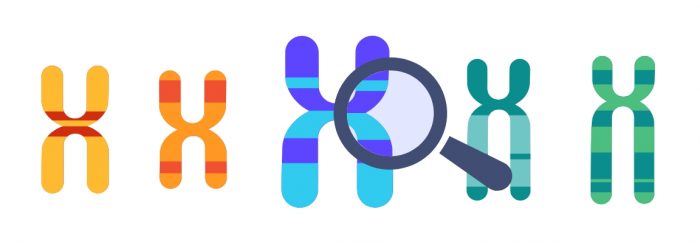Hereditary diseases are those that are transmitted from parents to children and whose origin is genetic, due to the presence of alterations in the cells of the germ line.
The genetic alterations that can cause a hereditary disease are diverse. When the cause is the presence of a pathogenic variant in a certain gene, they are called monogenic hereditary diseases. They are also called Mendelian diseases. In these, in general, the presence of a specific mutation in a single gene is responsible for an individual presenting a specific disease. In addition, these pathogenic variants can be transmitted to offspring, so in these cases it can be very useful and interesting to know whether one is a carrier of a certain mutation in order to receive the best advice and to be able to take the necessary measures when planning to have offspring.

Types of monogenic hereditary diseases
Monogenic hereditary diseases, which are mostly rare and infrequent diseases, can be classified according to the type of inheritance:
Autosomal recessive diseases:
Are those that occur when two copies of the mutated gene, located on a non-sex chromosome, are inherited. In these cases, generally, the parents are healthy carriers and both transmit the variant to their offspring.
One of the best known diseases of this type is cystic fibrosis. This disease is caused by the presence of mutations in the CFTR gene and is characterized by the accumulation of thick secretions in the lungs, gastrointestinal tract and other parts of the body. It is one of the most common monogenic inherited diseases.
Autosomal dominant diseases:
These are diseases in which the presence of one copy of the affected gene, located on a non-sex chromosome, is sufficient for their development.
Ehlers-Danlos syndrome is an example of this type of disease. There are several genes associated with this pathology and, although some cases are recessively inherited, most of them follow a dominant pattern. They originate from a defect in collagen synthesis and the clinical picture is very heterogeneous.
X-linked recessive diseases:
These are pathologies linked to the X sex chromosome, the development of which may depend on whether the affected person is male or female. Males have a single copy of the X chromosome (XY) while females have two copies of the X chromosome (XX). Therefore, in males, it is sufficient to have one copy of the mutated gene while in females, in general, two copies are necessary to have the disease.
Hemophilia A is a rare hemorrhagic disease caused by the presence of a mutation in the F8 gene, related to coagulation and located on the X chromosome. As it is recessively inherited, females are usually healthy carriers and the vast majority of those affected are males.
X-linked dominant diseases:
In these diseases, the affected gene is located on the X sex chromosome and one copy is sufficient to develop symptoms. In this case, if the mother is affected by the disease and is therefore the carrier of the mutation, all children will have the same probability of inheriting the variant, regardless of sex. However, if the affected person is the father, only his daughters will inherit the mutated gene because they are the only ones to whom the X chromosome is passed.
Y-linked disease:
Diseases caused by the presence of genetic alterations found on the Y chromosome, so only males are likely to be affected.
In addition to the genetic information contained in the cell nucleus (in the chromosomes) on which the above information is based, cells also have a small proportion of extranuclear DNA located in the mitochondria, which we inherit directly from our mothers. This mitochondrial DNA may also contain defects that lead to the development of certain pathologies such as, for example, Leber’s hereditary optic neuropathy.
Preimplantation genetic diagnosis
Thanks to the important impulse and development of research in biomedicine, the presence of many genetic alterations can be detected with Preimplantation Genetic Diagnosis (PGD). This technique consists of a genetic study of the embryos to detect these genetic alterations after in vitro fertilization. With this, it is possible to discard those that do not have certain characteristics or have a genetic defect, and thus transfer the selected embryos to the mother’s uterus.
There are social, ethical and legal controversies to apply these techniques at a global level. For the time being, PGD is permitted in Spain, Portugal and the United Kingdom, among others, but under specific conditions. In France it is highly restricted and can only be applied in very specific cases. And in Italy this procedure is, for the moment, prohibited.
It should be noted that, as this is a constantly evolving field, updated legislation should be consulted with the relevant professionals at the time this technique is to be applied.
PGD is always used in exceptional cases in which there is a well-founded risk of genetic disease and, usually, there is already a diagnosis or suspicion of genetic alteration in the parents. However, in most cases, those affected by hereditary diseases do not have a family history that would allow them to benefit from these techniques. For this reason, there are occasions when it can be useful for parents to resort to certain genetic tests such as tellmeGen, which analyzes a large number of pathogenic variants associated with various hereditary diseases, and thus be able to detect whether they are carriers of any of the mutations analyzed.



